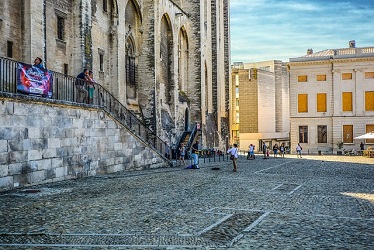 When I sang this piece with my own choir, I was intrigued by the title of this piece, as I associated Racine with Greek mythology. As a French minor in college I had read Racine’s play Phèdre, which has a story line about the hero Theseus, his second wife Phaedra, and his son from his first marriage, Hyppolite. I won’t go into the story here, but it sure doesn’t have anything to do with Christian theology!
When I sang this piece with my own choir, I was intrigued by the title of this piece, as I associated Racine with Greek mythology. As a French minor in college I had read Racine’s play Phèdre, which has a story line about the hero Theseus, his second wife Phaedra, and his son from his first marriage, Hyppolite. I won’t go into the story here, but it sure doesn’t have anything to do with Christian theology!
Racine simply used the myth as a plot, of course. And he himself was a Christian, belonging to a French sect called Jansenism. At some point in his career he translated a Latin hymn into French, and it was this translation that Fauré used for his piece and therefore why Racine’s name is used in the title. (So we’re singing an English translation of a French translation of a Latin original.)
But about Fauré. In looking up background on the “Cantique” I found out that he was sent to a school of religious music in Paris when he was nine years old. Isn’t that interesting? He’s not one of those composers whose parents tried to force him into doing something else. Instead, his musical talent was encouraged from childhood. He was taught piano, theory, composition, and classical languages at the school. His advanced piano teacher was none other than Camille Saint-Saëns, who encouraged his young pupil to compose. So at age nineteen, for the 1865-66 school year, he submitted the “Cantique” to the school composition contest and won. The piece was first performed in August of 1866.
I don’t usually try to get into any kind of musicological commentary in these posts, as I’m not very knowledgeable about that sort of thing, but in this instance I will say that I was a little taken aback when we had our first rehearsal to hear some dissonant notes in the accompaniment. I know it wasn’t that our peerless pianist was making mistakes. So I’ll fall back on Wikipedia, which quotes from a 2011 paper on the piece:
The long sweeping melodies and strong melodic and harmonic appoggiaturas in Cantique are a testament to the Romantic side of the piece, but there is a definite contemporary tint to what he’s writing, hidden in very minute and well-justified atonal note choices in the harmonic structure and melody. (Zachary Gates, “Paper on ‘Cantique de Jean Racine’”)
I would encourage you to listen for those “atonal notes.” Fauré’s use of them does indeed show a movement toward a more modern style, and I think of them as a means of keeping the music from being too sweet. (Sort of like putting chile powder in chocolate candy.)
The “Cantique” is important not just as a beautiful piece of music in and of itself but as a precursor of Fauré’s later and more monumental work, his Requiem. If hearing the “Cantique” inspires you to explore Fauré’s music further, so much the better!
Here’s a good performance:
© Debi Simons

